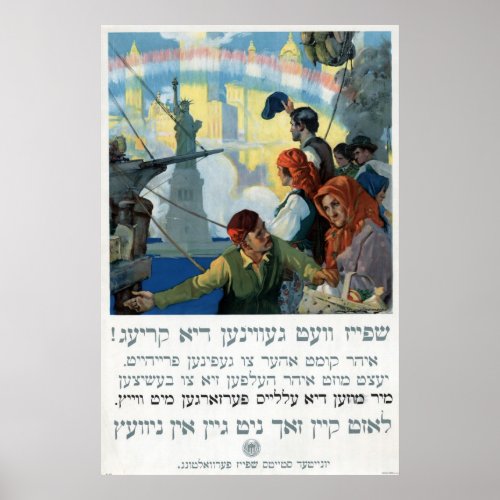Food Will Win The War World War 1 Poster



Caption (translated from the yiddish): "Food will win the war. You came here seeking freedom, now you must help to preserve it. Wheat is needed for the allies. Waste nothing." Exhibited at "From Haven to Home : A Library of Congress Exhibition Marking 350 Years of Jewish Life in America" at the Library of Congress, 2004. Yiddish (ייִדיש yidish or אידיש idish, literally "Jewish") is a High German language of Ashkenazi origin, spoken throughout the world. Yiddish is conventionally written in the Hebrew alphabet. The language originated in the Ashkenazi culture that developed from about the 10th century in the Rhineland and then spread to central and eastern Europe and eventually to other continents. In the earliest surviving references to it, the language is called לשון־אַשכּנז (loshn-ashkenaz = "language of Ashkenaz") and טײַטש (taytsh, a variant of tiutsch, the contemporary name for the language otherwise spoken in the region of origin, now called Middle High German; compare the modern New High German Deutsch). In common usage, the language is called מאַמע־לשון (mame-loshn, literally "mother tongue"), distinguishing it from biblical Hebrew and Aramaic, which are collectively termed לשון־קודש (loshn-koydesh, "holy tongue"). The term "Yiddish" did not become the most frequently used designation in the literature of the language until the 18th century. For a significant portion of its history, Yiddish was the primary spoken language of the Ashkenazi Jews and once spanned a broad dialect continuum from Western Yiddish to three major groups within Eastern Yiddish, namely Litvish, Poylish and Ukrainish. Eastern and Western Yiddish are most markedly distinguished by the extensive inclusion of words of Slavic origin in the Eastern dialects. While Western Yiddish has few remaining speakers, Eastern dialects remain in wide use. Yiddish is written and spoken in Orthodox Jewish communities around the world. It is a home language in most Hasidic communities, where it is the first language learned in childhood, used in schools, and in many social settings.


